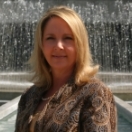
 Carolyn Hogg is being honored as a Champion of Change for her efforts in local innovation.
Carolyn Hogg is being honored as a Champion of Change for her efforts in local innovation.
I have worked for the private and public sectors in the area of banking, healthcare, and local government. In all of those fields, my career has been focused on supporting underprivileged populations, which has helped me develop the skills necessary to maximize limited resources our current economic times. During the recent economic downturn, my staff was reduced by 25 percent. I realized that we needed to find new ways to deliver core services. Recognizing that a city is only as good as the region surrounding it, I also saw an opportunity to reach out to community partners to transform government at the local level. This change in approach and opportunity to partner with Federal departments such as USDA as part of the Strong Cities/Strong Communities (SC2) program opened up conversations with the San Joaquin Valley Regional Broadband Consortium, Office of Community and Economic Development with California State University, Fresno, and other SC2 Federal teams to focus on bringing wireless broadband to the rural area and sharing common applications used among all municipalities throughout the region to maximize public funds.
There is a digital divide in the San Joaquin Valley between the urban core and the rural area. The rural area continues to struggle for connectivity and, if left unaddressed, larger food supply challenges could be faced, according to Robert Tse, USDA, one of my Federal partners from SC2. Our conversation began because we shared a common goal, “how to get connected”. From the city’s perspective, I’m working on a California Government Consortium concept that could transform the way local governments operate by using a shared secure pipeline to the state’s Federated Data Center to share common applications all cities and counties use to conduct business. The problem is the limited funds currently available that are specific to technology.
From USDA’s perspective, the San Joaquin Valley feeds 1/3 of the world with more than 350 different crops grown in our region which makes the San Joaquin Valley unique. Global demands for our crops are increasing as the population expands and becomes more urbanized. Our planet has, at most, 12 percent more land available for growing crops and our current water supply in the Central Valley just meets current demands. We need to “farm smarter” using water sensor technology that has the potential to save the equivalent amount of water in Lake Shasta annually and other innovative technologies that can potentially double our agricultural crop production, reduce energy consumption and double the amount of revenue coming into the Fresno region.
The missing link is wireless broadband in rural areas. Wireless broadband will allow for the use of new “smart-farming” technologies such as remote sensing devices at the field level to assess soil conditions, water and chemical needs, and climate changes and to control equipment such as tractors with GPS capability to plow smartly due to precise farming. Additional beneficiaries include our educational community as they embrace distance learning and mobile connectivity and our healthcare partners for tele-health to provide better patient screening at rural clinic sites.
Under our economic development umbrella, the opportunity to combine California’s strengths – agriculture and technology – will ignite our revitalization efforts by attracting high-tech agriculture companies to the downtown area which has been under-utilized and has become a financial drain. The downtown area is a perfect location for high-tech agriculture companies as we are working with telecommunication carriers to bring ultra-high speed broadband to the downtown corridor and other incentive areas within the city. Doug O’Brien, Deputy Under Secretary for Rural Development, has stated that he “envisions startups making broadband-dependent water sensors and other high tech agriculture equipment in the [San Joaquin] Valley. Tse also said, “Just as railroads brought economic growth to communities that were connected to the rail lines in the 19th century, and water ports provided the same connectivity in to cities in the centuries before, broadband offers the same access to prosperity in the 21st century”.
I see wireless broadband throughout our region, including the underserved areas, as “data” transportation to historical economic drivers.
My vision for the City of Fresno’s success is to partner with our regional stakeholders to bring wireless broadband to our entire community benefitting multiple stakeholders and, under the economic development umbrella, having the tools to help solve agriculture, economic, health, and social problems. Once the availability of ultra-high speed broadband in Downtown Fresno and other incentive areas are in place, the economy in our region will benefit. This infrastructure could serve as the underpinning for development of a regional agricultural technology cluster in Fresno, which means good jobs and would also help address the digital divide for urban and rural residents allowing for “Big Data” innovation.
Carolyn T. Hogg is the Chief Information Officer for Fresno, California.


